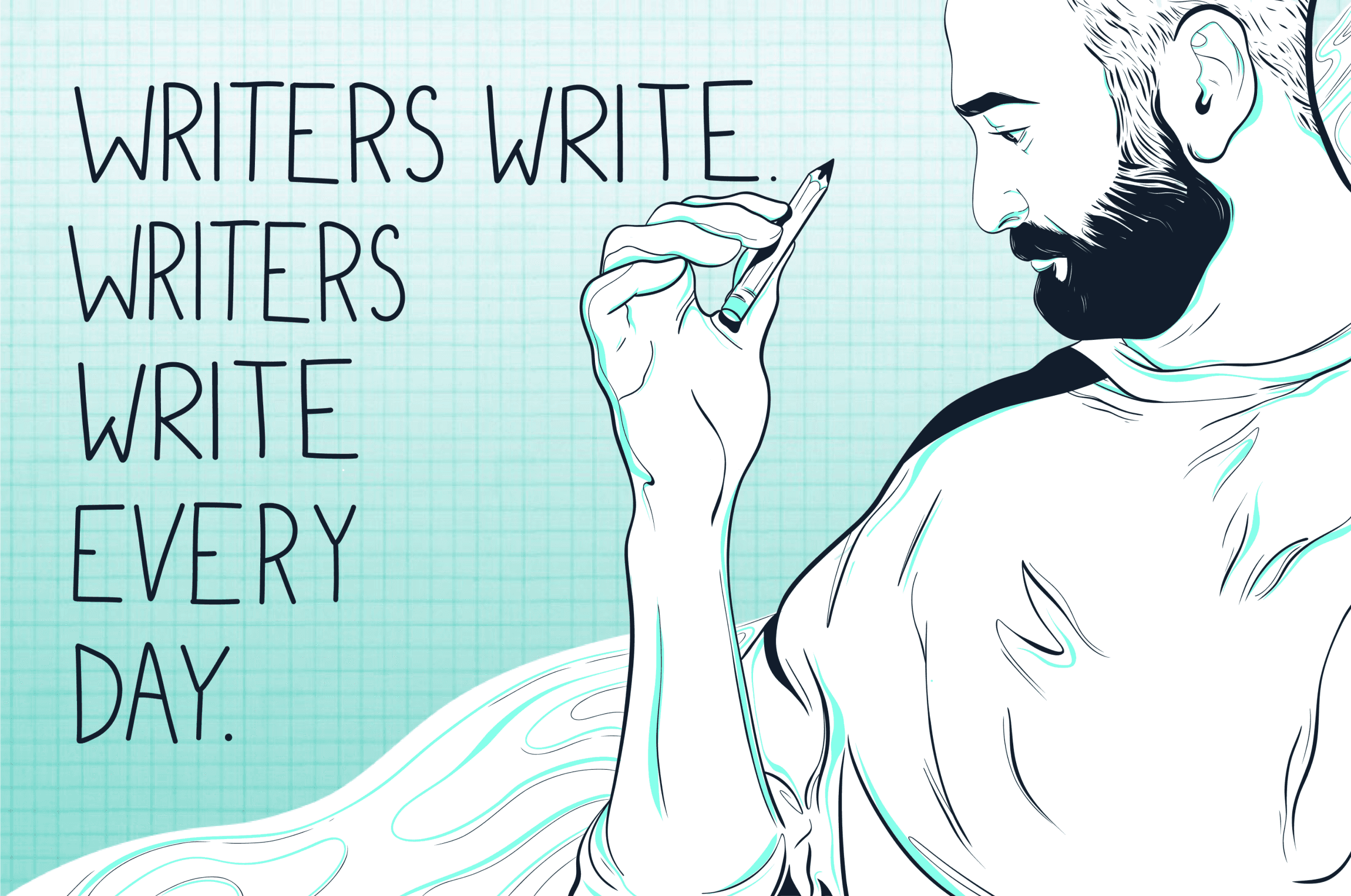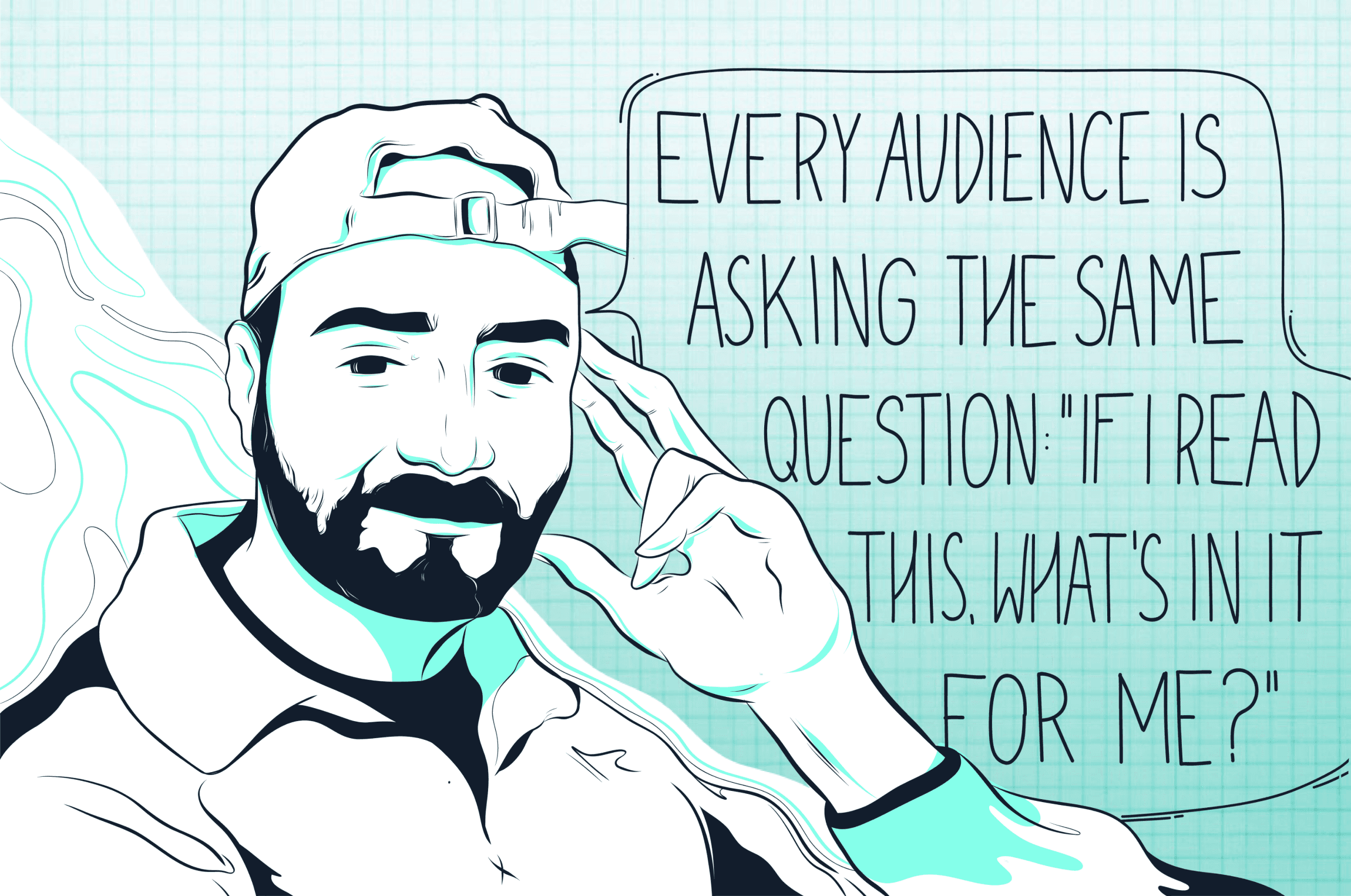Eddie Shleyner
This interview dates back to 2021, so a few details might be outdated. Either way we hope you enjoy the read :)
The Art of Writing with Eddie Shleyner
What should we ask Eddie? I said.
Andreas looked up from his laptop, smiled and asked me, what would you like to know about him?
My mind is racing, I want to know everything. I want to know how he writes so well, how he makes his words come alive, how with even a short post on LinkedIn, he teaches so many others like me to write better. Every single day.
So that's what we did. We had the amazing opportunity to sit down with Eddie Shleyner. He talks us through his journey. How he went from being rejected for a job at Hubspot to becoming a legend in the world of copywriting.
Let's hear from Eddie.
The backstory
Who was Eddie before VeryGoodCopy?
«I graduated with an English Lit degree from UIUC. I wanted to write books for a living. I got a job in Sales instead. Didn’t like it because I couldn’t stop thinking about writing. Then my roommate said his work had a “copywriter” opening.
“What’s that?” I said.
“Dunno,” he said.
I applied and got the job and I’ve been a student of persuasion since.»
What triggered you to start this community?
«I didn’t get hired at HubSpot, so I started documenting my copywriting education to “level up” I guess.
It was a personal project. I never imagined it would become what it is today.»
What’s the #1 thing you didn't expect with VeryGoodCopy?
«Practically, I never thought I’d actually pay for Mailchimp. When I signed up, my first 2000 subscribers were free.
I honestly didn’t think I’d get there. In fact, I scoffed at the notion. Now VeryGoodCopy has over 26,000 email subscribers and Mailchimp is one of my bigger business expenses.»
The LinkedIn effect
Eddie already had a successful newsletter when he started distributing his content on LinkedIn. He saw his engagement rate go up, up and away. That's when he realized LinkedIn was the place to build a direct line with his Readers.
VeryGoodCopy to LinkedIn. How did you start on LinkedIn?
«My “Micro-Articles” used to be longer, about 500 words. So I couldn’t fit them into a LinkedIn post, which, back then, maxed out at 1300 characters.
One day I wrote a 200-word article. It was about 1200 characters. I copy/pasted it into a LinkedIn post and it fit. Nice. I published it and the engagement rate soared. It was by far—by far—my most successful post.
So I leaned into creating shorter, punchier Micro-Articles I could publish in their entirety on LinkedIn. People kept engaging so I kept writing.»
What's LinkedIn's role in your life?
«It’s where I go to share my content and interact with my Readers.»
What did you want to achieve when you started on LinkedIn?
«I wanted to build a brand.»
What are three things you've achieved by being active on LinkedIn?
«- I built a social audience, an email list, and a reputation.
- I met and collaborated with my heroes, folks like Drayton Bird and Ann Handley and Ben Settle and Kim Krause Schwalm and many other writers whom I admire and respect and, frankly, never thought I’d meet, much less work with.
- I became self-employed.»

Writing for LinkedIn and for life
Writing is an art and as Eddie puts it, "Writers write. Writers write every day." Eddie talks about the importance of storytelling and consistency.
Is writing for LinkedIn different from writing elsewhere?
«Not really. I think all writing should be clear and concise and compelling.»
What's the #1 skill one needs to write impactful content for LinkedIn?
«Storytelling.»
Were you always great at writing and storytelling?
«Storytelling, perhaps. My dad is a gifted storyteller. I grew up listening to him and emulating him. Writing, no, absolutely not. I spent my college career and the decade since learning how to write—and I still have a lot of room to grow.»
What was your biggest mistake when starting out?
«My biggest writing mistake? Not doing it often enough.
Writers write. Writers write every day. You don’t have to publish something every day. But you do have to write. You have to give yourself a word count goal and hit it. I wish I did this sooner.»
Do you have a process for your LinkedIn content?
«I have an editorial calendar, which I keep up religiously. It helps me stay consistent.»
Who should build a personal brand on LinkedIn?
«Anybody who wants their reputation to precede them.»
Creator, copywriter, entrepreneur
Eddie made the jump from copywriter to copywriter and entrepreneur. He talks about his love for words and the journey ahead.
What's easier, being a copywriter or being an entrepreneur?
«Ha. Nice. I haven’t been an entrepreneur for as long as I’ve been a copywriter, so at this point, the latter is easier than the former because I have more experience.
Also, copywriting is my craft. I truly love the work. Being an entrepreneur is great, yeh, rewarding, yeh, but it’s not my passion.»
What's your opinion on the creator's economy?
«It’s a miracle.»
Does content creation have a role in the future of hiring?
«Sure. I think creative thinkers will always be in-demand.»
What's the most creative job application you've ever seen?
«Easy:
Alec Brownstein, a copywriter, bought Google ads for the names of Creative Directors he wanted to work for. So if—or more like when—those CDs Googled themselves (i.e., “vanity Googling”) the first result would be Alec’s ad, which read:
“Hey [Creative Director]. Googling yourself is a lot of fun. Hiring me is fun, too.”
He invested $6 in the campaign. Now he’s working at Y&R.»
Are you monetizing your LinkedIn audience?
«I started a paid community called VGC Plus.
I also get a lotta freelance requests.»
What's next for you? How do you level up from here?
«Next, I’ll release my first physical book. Followed by my first digital course.»

Fame and community
Each piece of content Eddie shares, whether it is on LinkedIn or on his newsletter delivers value upfront to his audience. He talks about how he structures his time to keep creating high-quality content consistently.
How do you handle being famous and yet so accessible to your audience?
«Ha! I dunno if I’m quite famous. But I also don’t know how accessible I am. I do my best to reply to comments and emails but I can’t get to all of them. Somebody actually called me out once on LinkedIn. He said I didn’t reply to his message.
I apologized.»
We see consistent value-packed content from you, how do you manage your time?
«I have scheduled 3-hour writing blocks, which I adhere to every morning.
Afternoons are for client projects and administrative work, scheduling, planning, emails.
I also record my ideas constantly, all day, as soon as they come to me. I’m draconian about this. I almost always write down my ideas. It helps me hit the ground running every morning. Or whenever I feel like writing, which is often.»
What's your #1 learning from creating content for multiple distribution channels and audiences?
«Every audience, across every channel, is asking the same question: “If I read this, what’s in it for me?”
People will trade their attention and engagement for one thing only: value. And value comes in two forms: entertainment or information.
If you can give people one or the other, good. If you can give people both at once, excellent.»
If I want to be like Eddie, where do I start?
«VeryGoodCopy.com is a fine start.»
Eddie in numbers
Eddie grew from 3,000 followers in March 2020 to +46,000 followers today. He uses his data to do more of what works and nurture his highly engaged audience.
How big was your audience on LinkedIn when you started and now?
«I joined LinkedIn around 2009, maybe 2010? By March 2020, I had about 3000 followers. By September 2021 I had over 46,000 followers.»
What's your most viral post ever? Was it about copywriting?
«Nah.
It was my son’s birth announcement:
~23,000 engagements
~2,500 comments
~650,000 views
People love babies. ❤️ »
Why do you track your LinkedIn performance?
«Mainly to understand what’s working and what isn’t. What does my audience care about? What do they want to see? “Marketing” is about following the markets, after all. It’s about understanding a specific group of people, so you can better give them what they want or need.
I also track my growth over time.»
What numbers do you track?
«My engagement rate (i.e., views-to-like/comment/share ratio) is important to me.
I track it on individual posts as well as across weekly, monthly, and quarterly periods.»
How do you use that information?
«It’s my quality barometer. The engagement rate is how I identify “successful” or “underperforming” content.
Then: I lean into successful formats and topics and I phase out the underperforming stuff.»
Things that inspire you
Three people on LinkedIn whose content you love
«Oof, so many talented folks.
But my desert island 3 would be Dave Harland and Drayton Bird and Kim Krause Schwalm, all excellent copywriters.»
Three books you would recommend others to read
«Ah, ok:
“Reach For The Sun” by Charles Bukowski:
While back, I picked up this collection of personal letters and was taken by Bukowski’s raw, simple style. A profound source of inspiration. It taught me: Great writing sounds familiar, like a note from a friend.
“The Adweek Copywriting Handbook” by Joe Sugarman:
A copywriting masterclass, clear, memorable, and overwhelming in its completeness. I’ll never stop recommending it. It taught me: The sole purpose of an ad’s 1st sentence is to get you to read the 2nd sentence.
“The Copy Book” by D&AD:
This book curates the most compelling and memorable ads of the 20th century. It also has a collection of essays written by the copywriters behind those ads. It taught me: Sometimes the best copy is no copy.»
Your favorite newsletter
«Dave Harland’s The Word.»
Your favorite movie
«Tough, very tough. I’m a cinephile.
But I can narrow it down to There Will Be Blood and Inglourious Basterds.»
Your favorite quote
“Simplicity is the ultimate sophistication.”
Amen.»
—
And that's it folks. A sneak peek into telling impactful stories with Eddie.
Make sure you Follow Eddie Shleyner on LinkedIn for more on storytelling and copywriting.
